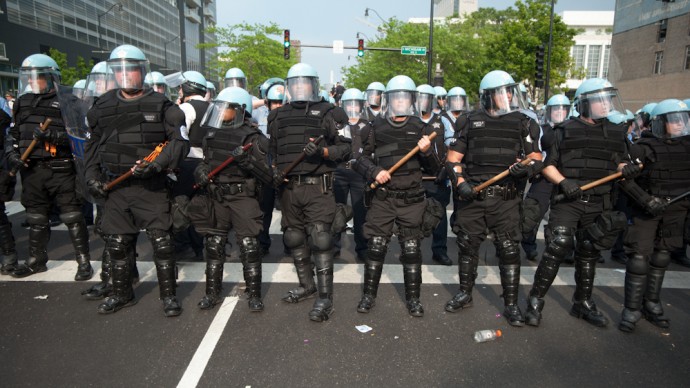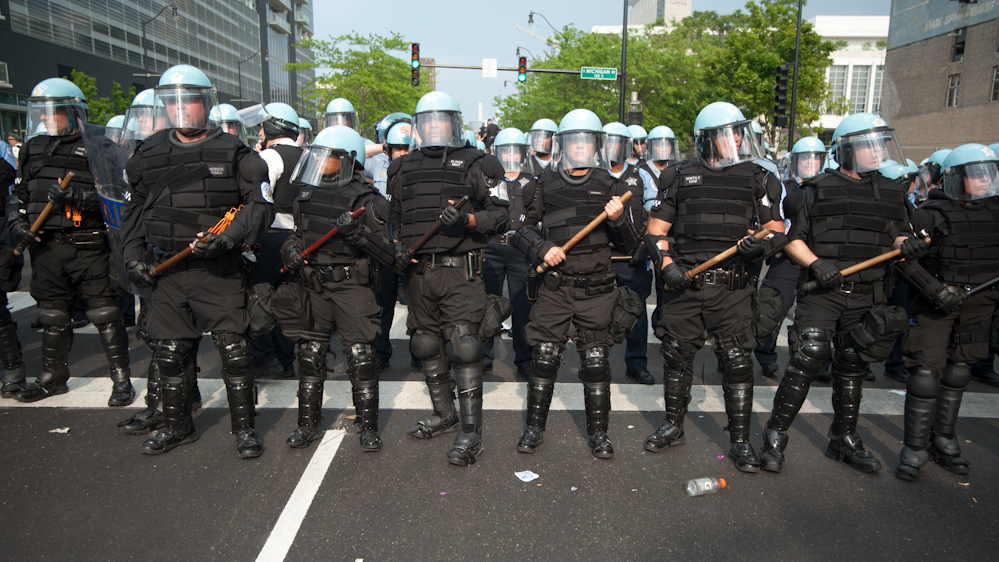
It has been said that “if all you’ve got is a hammer, then everything will look like a nail.” Increasingly, a militarized, hostile police force has emerged in America, which has moved away from community-oriented policing and taken a hardened posture combatting crime — typically, without adequate reserve or consideration toward the communities affected.
With police departments relying on special weapons, tactics, SWAT techniques and militarized equipment for routine police work at an accelerating basis, for many, the modern American police is starting to resemble a municipal army.
In 2011, New York Mayor Michael Bloomberg boasted incorrectly, “I have my own army in the NYPD, which is the seventh largest army in the world.” (The seventh largest army in the world actually belongs to Russia, with 350,000 to 400,000 deployable troops, compared to New York’s 33,000.)
However, with his own terrorism response center, mobilized strike units, paramilitary storm troopers and a citywide attitude of aggressively controlling the crime rate by any means necessary, it is understandable why Bloomberg would feel the way he did.
In an article for Community Policing Dispatch, the newsletter for the Justice Department’s Community-Oriented Policing Services Office, Senior Policy Analyst Karl Bickel argues that the military attitude of modern policing belies the police’s community role.
“Police chiefs and sheriffs may want to ask themselves—if after hiring officers in the spirit of adventure, who have been exposed to action oriented police dramas since their youth, and sending them to an academy patterned after a military boot camp, then dressing them in black battle dress uniforms and turning them loose in a subculture steeped in an ‘us versus them’ outlook toward those they serve and protect, while prosecuting the war on crime, war on drugs, and now a war on terrorism—is there any realistic hope of institutionalizing community policing as an operational philosophy?” Bickel wrote.
The rise of SWAT
In 2007, Radley Balko, the author of the Cato Institute’s “Overkill: The Rise of Paramilitary Police Raids in America,” told a House subcommittee that there has been a detected 1,500-percent increase in the use of SWAT teams over the last two decades. These raids, which Balko placed at about 40,000 per year, have increasingly moved from being used in response of emergency situations beyond the control of the regular police deployments — as SWAT was envisioned to be used for when first implemented by former Los Angeles Police Chief Daryl Gates in 1966 — to being used to service drug searches and arrests.
Since the 1981 passage of the Military Cooperation with Law Enforcement Act, which encourages the military to share with and give local, state and federal police access to military facilities, equipment and training toward fighting the “War on Drugs,” the amount of military equipment that has flooded not just major police departments, but small town police departments, has been startling. Combined with a sense of hyper-paranoia since the terrorist attacks of 9/11, and an increased investment in anti-terrorist funding and equipping of local agencies, the notion of the militarized police has went from rhetoric to a fact of life.
Recently, military surplus from the Iraq War, including 165 18-ton, armor-protected mine-resistant ambush-protected vehicles, has been distributed across the nation to sheriffs departments and agencies that do not have an immediate need for such equipment, including one going to the Ohio State University campus police and one going to the Albany County (NY) Sheriff Department, despite the MRAP being too heavy to be used on many of the county’s bridges and roads.
“It’s armored. It’s heavy. It’s intimidating. And it’s free,” said Albany County Sheriff Craig Apple, justifying his department’s adoption of the war vehicle.
Since 1990, $4.2 billion in military surplus has been distributed, according to The Associated Press. A disproportionate share of this has been found to have went to police and sheriff’s departments with little crime and few officers.
In 2012, Keene, N.H., which only has had two murders since 1999, was slated to receive a Bearcat — an eight-ton armored personnel vehicle, until protests from local residents delayed the acquisition.
“I don’t think there’s any place in the country where you can say, ‘That isn’t a likely terrorist target,'” said Jim Massery, government sales manager for the Bearcat’s manufacturer Lenco, in justifying why a town of 23,000 needs anti-terrorism equipment. “How would you know? We don’t know what the terrorists are thinking. No one predicted that terrorists would take over airplanes on Sept. 11. If a group of terrorists decide to shoot up a shopping mall in a town like Keene, wouldn’t you rather be prepared?”
A heavy hand
Many experts argue that the availability of a heavily-militarized response team would only encourage police departments to use it. On July 2008, Prince George’s County, Md. Sheriff’s Office intercepted a package of marijuana at a delivery service warehouse and completed the delivery in disguise. The Sheriff’s SWAT team raided the home, belonging to Berwyn Heights Mayor Cheye Calvo, handcuffing both the mayor and his mother-in-law and holding them at gunpoint for hours. The package, incidentally, was addressed to the mayor’s wife. The SWAT officers shot Calvo’s two Labrador retrievers, whom Calvo and his wife loved as children.
In an episode that has became a modern urban legend, it was revealed that no one at the Calvo residence was involved in drug dealing, as it was discovered that two drug smugglers used uninvolved innocent people to be the addressees in drug shipments. The fact that an improper search warrant was used in the case, the lack of a background investigation, the use of excessive force during the raid, and the notion that the sheriff refused to apologize for the gross act of misconduct led to Maryland being the first and only state in the Union to order each of its police departments to report on how often and why SWAT is used.
In Maryland’s first SWAT report in 2009, SWAT teams were deployed in Maryland roughly 4.5 times a day, with SWAT being deployed in Prince George’s County at least once a day. In a Baltimore Sun analysis, only 6 percent of SWAT dispatches were in response to barricades, bank robberies, hostage takings and other emergency situations that are part of SWAT’s original mission. More than half of Prince George’s County’s SWAT dispatches were for misdemeanor and non-serious felonies.
The cost of a hardened stance
A spokeswoman for the Prince George’s County Police asserted that the police assume the presence of weapons for every case, necessitating a tactical entry. But many feel that this hardening of the police — including the regular wearing of battle dress, carrying of assault weapons and the “act first and ask questions later” attitude — represents a trend in homeland security since 9/11 toward seeing everyone as a potential enemy. In taking this attitude, lives are jeopardized.
As chronicled recently in the press:
-
Aiyana Mo’nay Stanley-Jones, age 7, was shot in the head by a Detroit Special Response Team team officer in 2010. The team raided the wrong apartment, used a flash-bang grenade that set the blanket covering Aiyana on fire and kicked in unlocked doors. The theatrics were thought to be for the purposes of the A&E “The First 48” film crew that was shadowing the team.
“They had time,” a Detroit police detective told Mother Jones. “You don’t go into a home around midnight. People are drinking. People are awake. Me? I would have waited until the morning when the guy went to the liquor store to buy a quart of milk. That’s how it’s supposed to be done.”
After two debunked stories from the reporting police officers, the shooting officer was indicted on involuntary manslaughter.
-
In Fort Collins, Colorado earlier this year, two SWAT teams were deployed to shut down an entire neighborhood for four hours to search for a man suspected of stealing a bicycle and a cart full of merchandise from a Wal-Mart store. A reporter standing outside the command post of the two-street search radius was asked to move “out of the line of fire” by a sheriff’s deputy in full body armor.
-
In 2008, Connecticut’s Southwest Regional Emergency Response Team — while serving a drug warrant on Ronald Terebesi — shot and killed an unarmed Gonzalo Guizan. Guizan was shot six times by an officer who was confused from the use of flash-bang grenades. Despite hesitations from at least two of the officers for the seemingly excessive force, the raid was allowed to carry on — in part due to flawed and uncollaborated intelligence from an informant.
-
Chicago teenagers Thomas and Darren Russell, despite cooperating with SWAT officers in 2009 in response to a search warrant, were held at gunpoint and were forced to watch an officer shoot their dog. The teenagers asked permission to place the dog outside before the search. Thomas Russell was arrested for resisting arrest, but was found not guilty. The city and the police involved were forced to pay $333,000 to the Russell family in compensation.
“I suppose that maybe the ‘it needs to get worse before it will get better’ good news, here,” Balko told Vice. “As governments at all levels continue to expand the list of crimes for which they’re willing to send the SWAT team, we’ll inevitably see these tactics used against more people with more clout and stature to push for reform. It’s an unfortunate bit of realpolitik, but it’s undoubtedly true.”
A need for change
The reality of this trend is that the increased use of military equipment is only exacerbating the militarization of the police and not causing it. Many, including Balko, feel that this problem-oriented policing, which is increasingly alienating the police from the communities they protect, can only be solved by returning the police to the communities. That type of community-based policing will help to break down the animosity that exists between the public and the police.
Other reforms, including transparency in the use of force, removal of laws and challenges that prevent victims of botched raids from seeking damages, rescinding of asset forfeiture policies, tightening of search warrant requirements and strengthening civilian review boards will not only safeguard the public, but prevent the escalation of violence from increasingly endangering responding officers.
Taken with the alleged surveillance of American citizens, the injustices in drug prosecutions, and the nation’s hardened stance on immigration, the militarization of the police reflects an “overcriminalization” of America.
“A hammer is necessary to any toolkit,” Chase Madar wrote for Mother Jones. “But you don’t use a hammer to turn a screw, chop a tomato, or brush your teeth. And yet the hammer remains our instrument of choice, both in the conduct of our foreign policy and in our domestic order. The result is not peace, justice, or prosperity but rather a state that harasses and imprisons its own people while shouting ever less intelligibly about freedom.”


